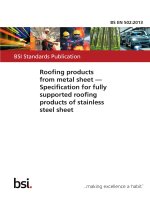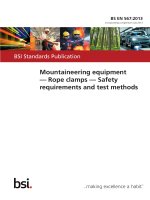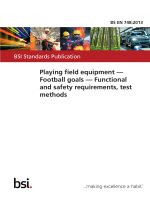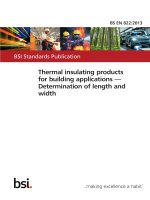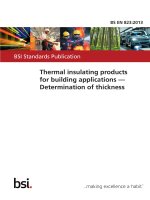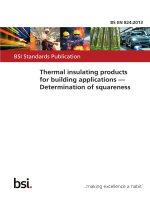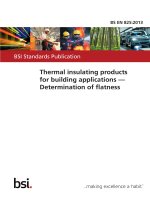Bsi bs en 62388 2013
Bạn đang xem bản rút gọn của tài liệu. Xem và tải ngay bản đầy đủ của tài liệu tại đây (2 MB, 180 trang )
BS EN 62388:2013
BSI Standards Publication
Maritime navigation and
radiocommunication
equipment and systems —
Shipborne radar —
Performance requirements,
methods of testing and
required test results
BS EN 62388:2013 BRITISH STANDARD
National foreword
This British Standard is the UK implementation of EN 62388:2013. It is
identical to IEC 62388:2013, incorporating corrigendum February 2014. It
supersedes BS EN 62388:2008, which will be withdrawn on 31 July 2016.
IEC corrigendum February 2014 corrects elements of subclause 16.1.7.2
and Table H.1.
The UK participation in its preparation was entrusted to Technical
Committee EPL/80, Maritime navigation and radiocommunication
equipment and systems.
A list of organizations represented on this committee can be obtained on
request to its secretary.
This publication does not purport to include all the necessary provisions of
a contract. Users are responsible for its correct application.
© The British Standards Institution 2014.
Published by BSI Standards Limited 2014
ISBN 978 0 580 74694 9
ICS 33.060; 47.020.70
Compliance with a British Standard cannot confer immunity from
legal obligations.
This British Standard was published under the authority of the
Standards Policy and Strategy Committee on 31 May 2014.
Amendments/corrigenda issued since publication
Date Text affected
EUROPEAN STANDARD BS EN 62388:2013
NORME EUROPÉENNE
EUROPÄISCHE NORM EN 62388
ICS 33.060; 47.020.70 October 2013
English version
Maritime navigation and radiocommunication equipment and systems -
Shipborne radar -
Performance requirements, methods of testing and required test results
(IEC 62388:2013)
Matériels et systèmes de navigation et de Navigations- und
radiocommunication maritimes - Funkkommunikationsgeräte und -systeme
Radars de bord - für die Seeschifffahrt -
Exigences de performance, méthodes Radar für Schiffe -
d’essai et résultats exigés Leistungsanforderungen, Prüfverfahren
(CEI 62388:2013) und geforderte Prüfergebnisse
(IEC 62388:2013)
This European Standard was approved by CENELEC on 2013-07-31. CENELEC members are bound to comply
with the CEN/CENELEC Internal Regulations which stipulate the conditions for giving this European Standard
the status of a national standard without any alteration.
Up-to-date lists and bibliographical references concerning such national standards may be obtained on
application to the CEN-CENELEC Management Centre or to any CENELEC member.
This European Standard exists in three official versions (English, French, German). A version in any other
language made by translation under the responsibility of a CENELEC member into its own language and notified
to the CEN-CENELEC Management Centre has the same status as the official versions.
CENELEC members are the national electrotechnical committees of Austria, Belgium, Bulgaria, Croatia, Cyprus,
the Czech Republic, Denmark, Estonia, Finland, Former Yugoslav Republic of Macedonia, France, Germany,
Greece, Hungary, Iceland, Ireland, Italy, Latvia, Lithuania, Luxembourg, Malta, the Netherlands, Norway, Poland,
Portugal, Romania, Slovakia, Slovenia, Spain, Sweden, Switzerland, Turkey and the United Kingdom.
CENELEC European Committee for Electrotechnical Standardization
Comité Européen de Normalisation Electrotechnique
Europäisches Komitee für Elektrotechnische Normung
CEN-CENELEC Management Centre: Avenue Marnix 17, B - 1000 Brussels
© 2013 CENELEC - All rights of exploitation in any form and by any means reserved worldwide for CENELEC members.
Ref. No. EN 62388:2013 E
BS EN 62388:2013
EN 62388:2013 - 2 -
Foreword
The text of document 80/696/FDIS, future edition 2 of IEC 62388, prepared by IEC TC 80 “Maritime
navigation and radiocommunication equipment and systems” was submitted to the IEC-CENELEC
parallel vote and approved by CENELEC as EN 62388:2013.
The following dates are fixed:
– latest date by which the document has to be implemented at (dop) 2014-04-30
national level by publication of an identical national
standard or by endorsement
– latest date by which the national standards conflicting with (dow) 2016-07-31
the document have to be withdrawn
This document supersedes EN 62388:2008.
EN 62388:2013 includes the following significant technical changes with respect to EN 62388:2008:
In 6.2 (Transmission and interference) reference is now made to a revised Annex B (Unwanted
emissions) where the mask has been tightened from 20 dB/decade to 30 dB/decade in line with
ITU requirements and a new informative Annex J has been added concerning interference from
emissions in adjacent frequency bands;
Clause 7 (Display presentation) has been simplified (and the previous Annexes J and K deleted)
with reference made instead to EN 62288 with associated changes throughout the standard;
In 9.9.2 (PI lines and positioning) the requirements for parallel index lines have been revised;
In 10.4.4 (Display orientation) a new mode of display orientation “head-up stabilised” has been
added;
In 11.5 (Automatic Identification System) new requirements and tests have been added for types
of AIS targets, AIS repeater stations and filtering of AIS targets;
In Clause 12 (Chart radar) a new subclause 12.3 has been added for ECDIS backup
requirements;
In Clause 13 (Ergonomic criteria) a new subclause 13.5 has been added giving requirements for
default control settings;
14.3 (Output interfacing) has been revised together with the associated Annex H to update the
requirements particularly with regard to interfaces to the VDR;
Clause 16 (Alerts and failures) has been revised to update the requirements to align with bridge
alert management and new requirements added for an alert management interface with
associated changes throughout the standard;
In Clause 18 (Equipment familiarisation and documentation) a new subclause 18.3 has been
added for maintenance information and equipment update.
Attention is drawn to the possibility that some of the elements of this document may be the subject of
patent rights. CENELEC [and/or CEN] shall not be held responsible for identifying any or all such
patent rights.
- 3 - BS EN 62388:2013
EN 62388:2013
Endorsement notice
The text of the International Standard IEC 62388:2013 was approved by CENELEC as a European
Standard without any modification.
In the official version, for Bibliography, the following notes have to be added for the standards indicated:
IEC 62616 NOTE Harmonised as EN 62616.
ISO 9000 NOTE Harmonised as EN ISO 9000.
ISO 9241-8 NOTE Harmonised as EN ISO 9241-8.
ISO 9241-12 NOTE Harmonised as EN ISO 9241-12.
BS EN 62388:2013
EN 62388:2013 - 4 -
Annex ZA
(normative)
Normative references to international publications
with their corresponding European publications
The following documents, in whole or in part, are normatively referenced in this document and are
indispensable for its application. For dated references, only the edition cited applies. For undated
references, the latest edition of the referenced document (including any amendments) applies.
NOTE When an international publication has been modified by common modifications, indicated by (mod), the
relevant EN/HD applies.
Publication Year Title EN/HD Year
IEC 60945 - EN 60945 -
series Maritime navigation and radiocommunication EN 61162 series
IEC 61162 - equipment and systems - General EN 61174 -
IEC 61174 requirements - Methods of testing and
2012 required test results EN 61924-2 2013
IEC 61924-2
2013 Maritime navigation and EN 61996-1 2013
IEC 61996-1 - radiocommunication equipment and EN 62288 -
systems - Digital interfaces
IEC 62288 - - -
- Maritime navigation and - -
ITU-R radiocommunication equipment and
Recommendation systems - Electronic chart display and
M.628 information system (ECDIS) - Operational
ITU-R and performance requirements, methods of
Recommendation testing and required test results
M.824
Maritime navigation and
radiocommunication equipment and
systems - Integrated navigation systems -
Part 2: Modular structure for INS -
Operational and performance
requirements, methods of testing and
required test results
Maritime navigation and radiocommunication
equipment and systems - Shipborne voyage
data recorder (VDR) -
Part 1: Performance requirements, methods
of testing and required test results
Maritime navigation and
radiocommunication equipment and
systems - Presentation of navigation-
related information on shipborne
navigational displays - General
requirements, methods of testing and
required test results
Technical characteristics for search and
rescue radar transponders
Technical parameters of radar beacons
(racons)
BS EN 62388:2013
- 5 - EN 62388:2013
Publication Year Title EN/HD Year
- - -
ITU-R Technical parameters of radar target -
Recommendation - enhancers -
M.1176 -
Specifications for chart content and display - -
IHO S-52 aspects of ECDIS
-
IHO S-52, - IHO ECDIS Presentation Library - -
-
Appendix 2, -
Annex A -
-
IMO Resolution - Performance standards for gyro- - -
A.424(IX) -
compasses -
-
IMO Resolution - General requirements for shipborne radio -
A.694(17) equipment forming part of the global
maritime distress and safety system
(GMDSS) and for electronic navigational
aids
IMO Resolution - Performance standards for gyro- -
A.821(19)
compasses for high-speed craft
IMO Resolution -
MSC.96(72) Amendments to performance standards for -
devices to indicate speed and distance
IMO Resolution - (resolution A.824(19))
MSC.116(73)
Performance standards for marine -
IMO Resolution -
MSC.191(79) transmitting heading devices (THDs)
Performance standards for the -
presentation of navigation-related
information on shipborne navigational
displays
IMO Resolution - Adoption of the revised performance -
MSC.192(79)
standards for radar equipment
IMO Resolution -
MSC.232(82) Revised performance standards for -
electronic chart display and information
systems (ECDIS)
IMO Resolution - Adoption of performance standards for -
MSC.302(87)
Bridge Alert Management
IMO - Guidance on procedures for updating -
MSC.1/Circ.1389 shipborne navigation and communication
equipment
VESA-2007-5 2007 Industry Standards and Guidelines for -
Computer Display Monitor Timing (DMT)
Standard
DDWG DVI 1999 Digital Visual Interface (DVI) Revision 1.0, -
Digital Display Working Group (DDWG)
– 2 – BS EN 62388:2013
62388 © IEC:2013(E)
CONTENTS
1 Scope.................................................................................................................... 14
2 Normative references.............................................................................................. 14
3 Terms and definitions.............................................................................................. 15
4 General ................................................................................................................. 27
4.1 Overview....................................................................................................... 27
4.2 Purpose ........................................................................................................ 28
4.3 Application of these standards......................................................................... 28
4.4 Equipment categories ..................................................................................... 28
4.5 Establishing equipment type and status............................................................ 29
4.6 Conditions of measurement and related definitions ............................................ 30
4.7 Quality requirements ...................................................................................... 30
5 Tests..................................................................................................................... 30
5.1 Test sites and simulation ................................................................................ 30
5.1.1 Environmental and RF testing............................................................... 30
5.1.2 Over-sea radar performance tests......................................................... 30
5.1.3 Test targets and target simulation for performance tests ......................... 31
5.2 Test terminology and format ............................................................................ 31
5.2.1 General .............................................................................................. 31
5.2.2 Test requirement terminology ............................................................... 31
5.2.3 Testing method terminology ................................................................. 32
6 Radar performance ................................................................................................. 32
6.1 General......................................................................................................... 32
6.2 Transmission and interference......................................................................... 32
6.2.1 Transmission frequency ....................................................................... 32
6.2.2 Interference ........................................................................................ 33
6.3 Performance optimisation and monitoring ......................................................... 33
6.3.1 General .............................................................................................. 33
6.3.2 Optimum performance ......................................................................... 33
6.4 Gain and anti-clutter functions ......................................................................... 34
6.4.1 General .............................................................................................. 34
6.4.2 Gain function ...................................................................................... 34
6.4.3 Manual and automatic sea anti-clutter ................................................... 34
6.4.4 Rain anti-clutter .................................................................................. 35
6.5 Signal processing........................................................................................... 35
6.5.1 General .............................................................................................. 35
6.5.2 Target enhancement............................................................................ 35
6.5.3 Radar signal correlation ....................................................................... 36
6.5.4 Signal processing and radar image latency ............................................ 36
6.5.5 Second-time-around echoes................................................................. 36
6.5.6 Transmission format ............................................................................ 37
6.5.7 Picture update .................................................................................... 37
6.5.8 Additional processing .......................................................................... 37
6.5.9 Signal processing description ............................................................... 37
6.6 Operation with SARTs, target enhancers (RTEs) and beacons............................ 38
6.6.1 General .............................................................................................. 38
BS EN 62388:2013 – 3 –
62388 © IEC:2013(E)
6.6.2 Radar beacons, SARTs and enhancers ................................................. 38
6.7 Minimum range and range compensation.......................................................... 38
6.7.1 General .............................................................................................. 38
6.7.2 Range compensation ........................................................................... 39
6.7.3 Minimum range ................................................................................... 39
6.8 Range and bearing discrimination .................................................................... 40
6.8.1 General .............................................................................................. 40
6.8.2 Measurement conditions ...................................................................... 40
6.8.3 Range discrimination ........................................................................... 40
6.8.4 Bearing discrimination ......................................................................... 40
6.8.5 Fundamental radar accuracy ................................................................ 41
6.9 Target detection performance assessment........................................................ 41
6.9.1 General .............................................................................................. 41
6.9.2 Range of first detection in minimal clutter .............................................. 42
6.9.3 Assessment of target detection with clutter ............................................ 44
6.9.4 Radar performance documentation........................................................ 49
6.10 Radar antenna (including pitch and roll) ........................................................... 50
6.10.1 General .............................................................................................. 50
6.10.2 Vertical radiation pattern/pitch and roll .................................................. 50
6.10.3 Antenna horizontal pattern ................................................................... 51
6.10.4 Antenna side lobes.............................................................................. 51
6.11 Radar availability – Standby and transmit ......................................................... 52
6.11.1 Requirements ..................................................................................... 52
6.11.2 Methods of test and required results ..................................................... 52
7 Display presentation ............................................................................................... 53
7.1 General......................................................................................................... 53
7.1.1 Requirements ..................................................................................... 53
7.1.2 Methods of test and required results ..................................................... 53
7.2 Linearity and index delay ................................................................................ 53
7.2.1 Requirements ..................................................................................... 53
7.2.2 Methods of test and required results ..................................................... 53
7.3 Use and discrimination of colour ...................................................................... 53
7.3.1 Requirements ..................................................................................... 53
7.3.2 Methods of test and required results ..................................................... 53
8 CCRP and own ship................................................................................................ 54
8.1 Consistent common reference point (CCRP) ..................................................... 54
8.1.1 CCRP ................................................................................................ 54
8.1.2 CCRP position .................................................................................... 54
8.1.3 Measurements .................................................................................... 54
8.1.4 Antenna offset .................................................................................... 55
8.2 Own ship....................................................................................................... 55
8.2.1 General .............................................................................................. 55
8.2.2 Own ship’s outline and minimised symbol .............................................. 55
8.2.3 Heading line ....................................................................................... 55
8.2.4 Stern line ........................................................................................... 56
9 Navigation tools...................................................................................................... 56
9.1 General......................................................................................................... 56
9.2 Units of measurement..................................................................................... 56
9.2.1 Requirements ..................................................................................... 56
– 4 – BS EN 62388:2013
62388 © IEC:2013(E)
9.2.2 Methods of test and required results ..................................................... 57
9.3 Presentation .................................................................................................. 57
9.3.1 Requirements ..................................................................................... 57
9.3.2 Methods of test and required results ..................................................... 57
9.4 Display range scales ...................................................................................... 57
9.4.1 Mandatory range scales....................................................................... 57
9.5 Variable range marker (VRM) .......................................................................... 58
9.5.1 General .............................................................................................. 58
9.5.2 VRM measurements ............................................................................ 58
9.6 Electronic bearing line (EBL) ........................................................................... 59
9.6.1 General .............................................................................................. 59
9.6.2 EBL measurements ............................................................................. 59
9.6.3 EBL origin position .............................................................................. 60
9.7 Cursor .......................................................................................................... 60
9.7.1 General .............................................................................................. 60
9.7.2 Cursor measurement ........................................................................... 60
9.7.3 Selection by cursor.............................................................................. 61
9.8 Offset measurement of range and bearing ........................................................ 61
9.8.1 General .............................................................................................. 61
9.8.2 Electronic range and bearing line (ERBL) .............................................. 61
9.9 Parallel index lines (PI)................................................................................... 62
9.9.1 General .............................................................................................. 62
9.9.2 PI lines and positioning........................................................................ 62
9.10 Bearing scale................................................................................................. 63
9.10.1 General .............................................................................................. 63
9.10.2 Bearing scale presentation................................................................... 63
9.11 Range rings................................................................................................... 64
9.11.1 General .............................................................................................. 64
9.11.2 Range ring presentation and measurement ............................................ 64
9.12 Radar maps................................................................................................... 65
9.12.1 General .............................................................................................. 65
9.12.2 Map functions and display simple user-defined maps .............................. 65
9.12.3 Map memory and transfer .................................................................... 65
9.12.4 Map presentation properties ................................................................. 66
9.13 Navigation routes ........................................................................................... 66
9.13.1 General .............................................................................................. 66
9.13.2 Route display and monitoring ............................................................... 67
10 Orientation, motion and stabilisation ......................................................................... 67
10.1 General......................................................................................................... 67
10.2 Azimuth orientation ........................................................................................ 67
10.2.1 Accuracy of alignment ......................................................................... 67
10.2.2 Heading readout and reference............................................................. 68
10.2.3 Azimuth stabilisation update ................................................................. 69
10.3 Motion and orientation modes.......................................................................... 69
10.3.1 General .............................................................................................. 69
10.3.2 True and relative motion ...................................................................... 69
10.4 Off-centring ................................................................................................... 70
10.4.1 General .............................................................................................. 70
10.4.2 Manual and automatic off-centring ........................................................ 70
BS EN 62388:2013 – 5 –
62388 © IEC:2013(E)
10.4.3 Automatic reset................................................................................... 70
10.4.4 Display orientation .............................................................................. 71
10.5 Ground and sea stabilisation ........................................................................... 72
10.5.1 Mode and source ................................................................................ 72
10.5.2 Ground stabilisation ............................................................................ 72
10.5.3 Sea stabilisation ................................................................................. 73
11 Aids for collision avoidance ..................................................................................... 73
11.1 General......................................................................................................... 73
11.2 Target trails and past positions........................................................................ 73
11.2.1 General .............................................................................................. 73
11.2.2 Time and plot requirements .................................................................. 74
11.2.3 Trails/past position availability .............................................................. 74
11.3 Target tracking (TT) ....................................................................................... 75
11.3.1 General............................................................................................ 75
11.3.2 Presentation of targets ...................................................................... 75
11.3.3 Tracking calculations......................................................................... 76
11.3.4 Target tracking availability ................................................................. 76
11.3.5 Classification and tracked target capacity ............................................ 77
11.3.6 Manual acquisition ............................................................................ 78
11.3.7 Automatic acquisition ........................................................................ 78
11.3.8 Motion trend ..................................................................................... 78
11.3.9 Visibility of 50 % ............................................................................... 79
11.3.10 Tracking algorithm ............................................................................ 79
11.3.11 Target swap ..................................................................................... 79
11.3.12 Cease tracking.................................................................................. 79
11.3.13 Target tracking scenarios................................................................... 79
11.3.14 Target motion and tracking accuracy................................................... 80
11.3.15 Tracker range and bearing accuracy ................................................... 88
11.3.16 Reference target ............................................................................... 89
11.4 Tracking limitations ........................................................................................ 89
11.4.1 Tracking warnings ............................................................................... 89
11.4.2 Documentation.................................................................................... 90
11.4.3 Requirements ..................................................................................... 90
11.4.4 Methods of test and required results ..................................................... 90
11.5 Automatic identification system........................................................................ 90
11.5.1 General .............................................................................................. 90
11.5.2 AIS targets and data report capacity ..................................................... 90
11.5.3 AIS target filtering ............................................................................... 92
11.5.4 Activation and deactivation of AIS targets .............................................. 92
11.5.5 AIS functionality and presentation ......................................................... 93
11.6 Radar and AIS target data............................................................................... 95
11.6.1 Requirements ..................................................................................... 95
11.6.2 Methods of test and required results ..................................................... 95
11.6.3 Bow crossing range and time (BCR/BCT)............................................... 96
11.7 Operational target alerts ................................................................................. 96
11.7.1 CPA and TCPA ................................................................................... 96
11.7.2 New target warning ............................................................................. 97
11.7.3 Lost tracked radar target...................................................................... 97
11.7.4 Lost AIS target criteria ......................................................................... 98
– 6 – BS EN 62388:2013
62388 © IEC:2013(E)
11.8 Target association.......................................................................................... 99
11.8.1 General .............................................................................................. 99
11.8.2 Association and priority........................................................................ 99
11.9 Trial manoeuvre........................................................................................... 103
11.9.1 General ............................................................................................ 103
11.9.2 Trial functions ................................................................................... 103
12 Chart radar (optional classification) ........................................................................ 104
12.1 General requirements ................................................................................... 104
12.1.1 General.......................................................................................... 104
12.1.2 Chart operation and source .............................................................. 104
12.1.3 Chart elements and availability ......................................................... 105
12.1.4 Chart reference............................................................................... 106
12.1.5 Primary chart information set............................................................ 106
12.1.6 Chart stabilisation and chart redraw .................................................. 107
12.1.7 Chart position and latency................................................................ 108
12.1.8 Matching and adjustment ................................................................. 108
12.1.9 Chart symbols, colours, and size ...................................................... 109
12.1.10 Chart display size ........................................................................... 110
12.1.11 Chart alerts and indications.............................................................. 110
12.1.12 Chart malfunction............................................................................ 111
12.1.13 Chart radar malfunction ................................................................... 111
12.2 Additional requirements for standalone radar with chart facilities....................... 111
12.2.1 General ............................................................................................ 111
12.2.2 Provision and updating of chart information ......................................... 111
12.2.3 Content and structure of chart data ..................................................... 112
12.3 Additional requirements for ECDIS back-up (optional) ...................................... 112
12.3.1 General ............................................................................................ 112
12.3.2 Requirements ................................................................................... 112
12.3.3 Test Methods and required results ...................................................... 112
13 Ergonomic criteria (control functions and display) .................................................... 112
13.1 General....................................................................................................... 112
13.2 Operational controls ..................................................................................... 112
13.2.1 Requirements ................................................................................... 112
13.2.2 Methods of test and required results ................................................... 113
13.3 Primary controls........................................................................................... 113
13.3.1 Requirements ................................................................................... 113
13.3.2 Methods of test and required results ................................................... 113
13.4 Control properties ........................................................................................ 114
13.4.1 Requirements ................................................................................... 114
13.4.2 Methods of test and required results ................................................... 114
13.5 Default control setting and saved user control settings..................................... 114
13.5.1 Requirements ................................................................................... 114
13.5.2 Test methods and required results ...................................................... 115
14 Interfacing ........................................................................................................... 116
14.1 General....................................................................................................... 116
14.2 Input interfacing ........................................................................................... 116
14.2.1 Input data......................................................................................... 116
14.2.2 Input quality, integrity and latency....................................................... 117
14.3 Output interfacing ........................................................................................ 117
BS EN 62388:2013 – 7 –
62388 © IEC:2013(E)
14.3.1 Output format ................................................................................... 117
14.3.2 Output target data ............................................................................. 117
14.3.3 VDR interface ................................................................................... 118
15 Design, servicing and installation ........................................................................... 119
15.1 General....................................................................................................... 119
15.2 Fault diagnosis and servicing ........................................................................ 119
15.2.1 Requirements ................................................................................... 119
15.2.2 Methods of test and required results ................................................... 120
15.3 Display design ............................................................................................. 120
15.3.1 Requirements ................................................................................... 120
15.3.2 Methods of test and required results ................................................... 120
15.4 Transceiver design ....................................................................................... 120
15.4.1 General ............................................................................................ 120
15.4.2 Sector blanking ................................................................................. 121
15.5 Antenna design............................................................................................ 121
15.5.1 Requirements ................................................................................... 121
15.5.2 Methods of test and required results ................................................... 121
15.6 Inter-switched and multiple radars ................................................................. 122
15.6.1 General ............................................................................................ 122
15.6.2 System safeguards............................................................................ 122
15.6.3 Combining radar ............................................................................... 122
15.6.4 Multiple radar system status............................................................... 123
15.7 Multiple operational displays ......................................................................... 123
15.7.1 Additional information and conformity .................................................. 123
15.7.2 Requirements ................................................................................... 123
15.7.3 Methods of test and required results ................................................... 124
15.8 Safety – antenna and radiation ...................................................................... 124
15.8.1 General ............................................................................................ 124
15.8.2 Antenna radiation and rotation............................................................ 124
15.8.3 Microwave radiation levels ................................................................. 124
16 Alerts and failures................................................................................................. 125
16.1 General....................................................................................................... 125
16.1.1 Priority of alerts ................................................................................ 125
16.1.2 Alerts and indications ........................................................................ 125
16.1.3 Alarm contact outputs ........................................................................ 125
16.1.4 Alert management interface................................................................ 125
16.1.5 Unacknowledged warnings ................................................................. 126
16.1.6 Unacknowledged alarms .................................................................... 127
16.1.7 Remote acknowledgement and silencing of alerts ................................. 127
16.1.8 Picture freeze ................................................................................... 128
16.1.9 Sensor failure alert ............................................................................ 128
16.2 Backup and fallback arrangements ................................................................ 128
16.2.1 Requirements ................................................................................... 128
16.2.2 Failure of heading information (azimuth stabilisation) ............................ 128
16.2.3 Failure of speed through the water information..................................... 129
16.2.4 Failure of course and speed over ground information ............................ 129
16.2.5 Failure of position input information .................................................... 129
16.2.6 Failure of radar video input information ............................................... 130
16.2.7 Failure of AIS input information........................................................... 130
– 8 – BS EN 62388:2013
62388 © IEC:2013(E)
16.2.8 Failure of an integrated or networked system ....................................... 130
17 Environmental testing ........................................................................................... 130
17.1 General....................................................................................................... 130
17.2 Testing to IEC 60945.................................................................................... 131
17.2.1 Requirements ................................................................................... 131
17.2.2 Methods of test and required results ................................................... 131
17.3 Additional environmental tests ....................................................................... 131
17.3.1 General ............................................................................................ 131
17.3.2 Antenna shock test ............................................................................ 132
18 Equipment familiarisation and documentation .......................................................... 132
18.1 Familiarisation simulator ............................................................................... 132
18.1.1 General ............................................................................................ 132
18.1.2 Requirements ................................................................................... 132
18.1.3 Methods of test and required results ................................................... 132
18.2 Instructions and documentation ..................................................................... 133
18.2.1 General ............................................................................................ 133
18.2.2 Documentation.................................................................................. 133
18.2.3 Operating instructions........................................................................ 133
18.3 Radar system installation .............................................................................. 134
18.3.1 Requirements ................................................................................... 134
18.3.2 Methods of test and required results ................................................... 134
18.4 Maintenance information for equipment update ............................................... 135
18.4.1 Requirements ................................................................................... 135
18.4.2 Methods of test and required results ................................................... 135
Annex A (informative) Guidelines for radar functionality on navigation displays ................ 136
Annex B (normative) Unwanted emissions of radar systems........................................... 137
Annex C (informative) Radar target size (RCS) and detection range calculations ............. 142
Annex D (informative) Factors that influence target detection......................................... 146
Annex E (normative) Sensor errors.............................................................................. 155
Annex F (informative) Target scenario simulator/reported target simulator....................... 157
Annex G (informative) Tracked and reported target states ............................................. 158
Annex H (normative) IEC 61162 sentence formats ........................................................ 159
Annex I (normative) Radar control function/indication grouping ...................................... 168
Annex J (informative) Interference to shipborne radar from emissions in adjacent
frequency bands......................................................................................................... 172
Bibliography............................................................................................................... 175
Figure 1 – Reduction of range to first detection due to rain at S-band ................................ 45
Figure 2 – Reduction of range to first detection due to rain at X-band ................................ 45
Figure 3 – TT scenario 1 ............................................................................................... 82
Figure 4 – TT scenario 2 ............................................................................................... 83
Figure 5 – TT scenario 3 ............................................................................................... 84
Figure 6 – TT scenario 4 ............................................................................................... 85
Figure 7 – TT scenario 5 ............................................................................................... 86
Figure B.1 – B–40 falls within the allocated band ........................................................... 140
Figure B.2 – B–40 falls outside the allocated band ......................................................... 141
BS EN 62388:2013 – 9 –
62388 © IEC:2013(E)
Figure C.1 – Enhancement by reflection (dB) over free-space (9,41 GHz) ........................ 145
Figure C.2 – Enhancement by reflection (dB) over free-space (3,05 GHz) ........................ 145
Figure D.1 – Effect of sea spikes on target detection...................................................... 148
Figure D.2 – Multi-path plots for S-band........................................................................ 150
Figure D.3 – Multi-path plot for X-band ......................................................................... 150
Figure G.1 – Tracked target states ............................................................................... 158
Figure G.2 – AIS target state ....................................................................................... 158
Table 1 – Performance requirements for categories of ship/craft for SOLAS V .................... 29
Table 2 – Range of first detection in clutter-free conditions ............................................... 42
Table 3 – X-band pass/fail assessment criteria ................................................................ 48
Table 4 – S-band pass/fail assessment criteria ................................................................ 48
Table 5 – Pass/fail assessment...................................................................................... 49
Table 6 – Douglas sea state parameters ......................................................................... 49
Table 7 – Main horizontal beam pattern .......................................................................... 51
Table 8 – Effective side-lobes ........................................................................................ 52
Table 9 – Features and colours to be used for radar maps................................................ 66
Table 10 – Tracked target capacity (subset of Table 1)..................................................... 77
Table 11 – Typical tracked target accuracy (95 % probability figures) ................................ 80
Table 12 – TT scenario 1, with sensor errors applied ....................................................... 81
Table 13 – TT scenario 1, times of measurement task ...................................................... 81
Table 14 – TT scenario 1, accuracies after 1 min and 3 min (all ± values) .......................... 82
Table 15 – TT scenario 2, own ship turning through ± 180° ............................................... 83
Table 16 – TT scenario 3, initial target data..................................................................... 84
Table 17 – TT scenario 4, initial target data for fast targets (standard speed ships) ............. 84
Table 18 – TT scenario 4, initial target data for fast targets (HSC) ..................................... 85
Table 19 – TT scenario 5: initial target data for standard craft ........................................... 86
Table 20 – TT scenario 5: initial target data for collision scenario for HSC.......................... 86
Table 21 – Measurement points and results at 3 min and 6 min for HSC ............................ 87
Table 22 – Measurement points and results at 11 min and 14 min for HSC ......................... 87
Table 23 – Measurement points and results at 3 min and 6 min for standard craft ............... 87
Table 24 – Measurement points and results at 11 min and 14 min for standard craft............ 88
Table 25 – Measurement of tracked target accuracy......................................................... 88
Table 26 – AIS display capacity (subset of Table 1) ......................................................... 91
Table 27 – AIS reporting rates ....................................................................................... 98
Table 28 – Association scenario 1, initial TT and AIS target position and data .................. 100
Table 29 – Association scenario 1, AIS target data for diverging and converging tracks .... 101
Table 30 – Association scenario 2, initial TT and AIS target position and data .................. 101
Table 31 – Association scenario 2, AIS target data for changing speed ............................ 102
Table 32 – Association scenario 3, TT and AIS target start position and data.................... 102
Table 33 – Association scenario 4, initial TT and AIS target position and data .................. 103
Table 34 – Association scenario 4, TT and AIS target with the same course and speed .... 103
Table 35 – Control settings configured in response to ‘Default’ selection.......................... 115
– 10 – BS EN 62388:2013
62388 © IEC:2013(E)
Table 36 – Antenna shock test severity (half sine pulse)................................................. 132
Table B.1 – Measurement frequency ranges.................................................................. 138
Table D.1 – Spread of RCS values for typical ships........................................................ 147
Table D.2 – S-band performance predictions for ranges of 0,2, 0,4, 0,7 NM...................... 149
Table D.3 – X-band performance predictions for ranges of 0,2, 0,7 NM ............................ 149
Table D.4 – Parameters for attenuation in uniform rain conditions ................................... 151
Table D.5 – Typical values for attenuation and backscatter in uniform rain conditions........ 151
Table D.6 – Additional radar system parameters (X/S-band) ........................................... 151
Table D.7 – Target size, height and RCS values ............................................................ 152
Table D.8 – S-band radar parameters (LP) .................................................................... 153
Table D.9 – X-band radar parameters (LP) .................................................................... 154
Table H.1 – Mandatory IEC 61162-1 sentences ............................................................. 159
Table H.2 – Optional IEC 61162-3 messges .................................................................. 160
Table H.3 – Description of terms .................................................................................. 161
Table H.4 – Header format (1 of 2) ............................................................................... 162
Table H.5 – Package data format ................................................................................. 164
Table I.1 – Top-level grouping of data and control functions for radar applications ............ 168
Table I.2 – Icons for common function controls (1 of 2)................................................... 169
– 14 – BS EN 62388:2013
62388 © IEC:2013(E)
MARITIME NAVIGATION AND RADIOCOMMUNICATION
EQUIPMENT AND SYSTEMS –
Shipborne radar – Performance requirements,
methods of testing and required test results
1 Scope
This International Standard specifies the minimum operational and performance requirements,
methods of testing and required test results conforming to performance standards not inferior
to those adopted by the IMO in Resolution MSC.192(79).
(MSC.192/2) The radar installation, in addition to meeting the general requirements as set out
in resolution A.694(17) and the related standard IEC 60945, should comply with the
performance standards of MSC.192(79). When a requirement of this standard is different from
IEC 60945, the requirement in this standard takes precedence.
2 Normative references
The following documents, in whole or in part, are normatively referenced in this document and
are indispensable for its application. For dated references, only the edition cited applies. For
undated references, the latest edition of the referenced document (including any
amendments) applies.
IEC 60945, Maritime navigation and radiocommunication equipment and systems – General
requirements – Methods of testing and required test results
IEC 61162 (all parts), Maritime navigation and radiocommunication equipment and systems –
Digital interfaces
IEC 61174, Maritime navigation and radiocommunication equipment and systems – Electronic
chart display and information systems (ECDIS) – Operational and performance requirements,
methods of testing and required test results
IEC 61924-2:2012, Maritime navigation and radiocommunication equipment and systems –
Part 2 Modular Structure for INS - Operational and performance requirements, methods of
testing and required test results
IEC 61996-1:2012, Maritime navigation and radiocommunication equipment and systems –
Shipborne voyage data recorder (VDR) – Part 1: Voyage data recorder (VDR) - Performance
requirements – Methods of testing and required test results
IEC 62288, Maritime navigation and radiocommunication equipment and systems –
Presentation of navigation-related information on shipborne navigational displays – General
requirements, methods of testing and required results
ITU-R Recommendation M.628, Technical characteristics for search and rescue radar
transponders
ITU-R Recomendation M.824, Technical parameters of radar beacons (racons)
ITU-R Recommendation M.1176, Technical parameters of radar target enhancers
BS EN 62388:2013 – 15 –
62388 © IEC:2013(E)
IHO S-52, Specifications for chart content and display aspects of ECDIS
IHO S-52 Annex A, IHO ECDIS Presentation Library
IMO Resolution A.424(XI), Performance standards for Gyro-compasses
IMO Resolution A.694(17), General requirements for shipborne radio equipment forming part
of the global maritime distress and safety system (GMDSS) and for electronic navigational
aids
IMO Resolution A.821(19), Performance standards for Gyro-compasses for High-Speed Craft
IMO Resolution MSC.96(72), Amendments to IMO Resolution A.824(19), Performance
standards for devices to indicate speed and distance
IMO Resolution MSC.116(73), Performance standards for marine transmitting heading devices
(THDs)
IMO Resolution MSC.191(79), Performance standards for the presentation of navigation-
related information on shipborne navigational displays
IMO Resolution MSC.192(79), Revised performance standards for radar equipment
IMO Resolution MSC.232(82), Revised performance standards for electronic chart display and
information systems (ECDIS)
IMO Resolution MSC.302(87), Performance standards for bridge alert management
IMO MSC.1/Circ.1389, Guidance on procedures for updating shipborne navigation and
communication equipment
VESA-2007-5:2007, Industry standards and guidelines for computer display monitor timing
(DMT)
DDWG DVI:1999, Digital Visual Interface (DVI) Revision 1.0, Digital Display Working Group
(DDWG)
3 Terms and definitions
For the purposes of this document, the following terms and definitions apply.
3.1
activated AIS target
target representing the automatic or manual activation of a sleeping target for the display of
additional graphically presented information
Note 1 to entry: The target is displayed by an “activated target” symbol including a vector; the heading; and the
ROT or direction of turn indication (if available) to indicate initiated course changes.
[SOURCE: IMO Resolution MSC.192(79):2004, Appendix 2, modified – added Note 1 to entry]
3.2
acquisition of a radar target
process of acquiring a target and initiating its tracking
[SOURCE: IMO Resolution MSC.192(79):2004, Appendix 2]
– 16 – BS EN 62388:2013
62388 © IEC:2013(E)
3.3
activation of an AIS target
activation of a sleeping AIS target for the display of additional graphical and alphanumerical
information
[SOURCE: IMO Resolution MSC.192(79):2004, Appendix 2]
3.4
acquired radar target
automatic or manual acquisition initiates radar tracking
Note 1 to entry: Vectors and past positions (if provided) are displayed when data has achieved a steady state
condition (after 1 min).
[SOURCE: IMO Resolution MSC.192(79):2004, Appendix 2, modified – added Note 1 to entry]
3.5
automatic identification system
AIS
Automatic Identification System which complies with the requirements of IMO resolution
MSC.74(69) Annex 3 and IEC 61993-2
3.6
AIS target
target generated from an AIS message
[SOURCE: IMO Resolution MSC.192(79):2004, Appendix 2, modified – deleted referral to
other targets]
3.7
associated target
target simultaneously representing a tracked target and a reported AIS target having similar
parameters (for example position, course, speed) which comply with an association algorithm
[SOURCE: IMO Resolution MSC.192(79):2004, Appendix 2, modified – deleted examples]
3.8
acquisition/activation zone
zone set up by the operator in which the system should automatically acquire radar targets
and activate reported AIS targets when entering the zone
[SOURCE: IMO Resolution MSC.192(79):2004, Appendix 2]
3.9
azimuth-stabilised
heading reference input, for example own ship’s gyro, is used to orientate the heading line on
the radar display so that it points from the CCRP to own ship’s referenced heading on the
bearing scale
3.10
bow crossing range/bow crossing time
BCR/BCT
measurements presented as from the bow of the ship as opposed to the CCRP
3.11
cardinal points (compass)
0, 090, 180, 270 compass points
BS EN 62388:2013 – 17 –
62388 © IEC:2013(E)
3.12
consistent common reference point
CCRP
location on own ship, to which all horizontal measurements such as target range, bearing,
relative course, relative speed, closest point of approach (CPA) or time to closest point of
approach (TCPA) are referenced, typically the conning position of the bridge
[SOURCE: IMO Resolution MSC.192(79):2004, Appendix 2]
3.13
closest point of approach/time to the closest point of approach
CPA/TCPA
distance to the closest point of approach (CPA) and time to the closest point of approach
(TCPA)
Note 1 to entry: Limits are set by the operator and are related to own ship.
[SOURCE: IMO Resolution MSC.192(79):2004, Appendix 2, modified – added Note 1 to entry]
3.14
course
direction in which the ship is moving or intended to move, expressed in degrees from North,
usually from 000° at north, then in a clockwise direction through 360°
3.15
course over ground
COG
direction of the ship's movement relative to the earth, measured on board the ship, expressed
in angular units from true north
[SOURCE: IMO Resolution MSC.192(79):2004, Appendix 2]
3.16 water, defined by the angle between the
course through water of the ship's movement through the water,
CTW
direction of the ship's movement through the
meridian through its position and the direction
expressed in angular units from true north
[SOURCE: IMO Resolution MSC.192(79):2004, Appendix 2]
3.17
course-up
C-up
azimuth-stabilised display in which the bearing scale can be orientated so that own ship’s
course on the bearing scale is vertically above the CCRP
Note 1 to entry: The heading line will continue to point from the CCRP to own ship’s referenced heading on the
bearing scale.
Note 2 to entry: If own ship’s heading differs from the course, then the heading line will not point vertically
upwards from the CCRP until the bearing scale is reset (manually or automatically) to reflect the course alteration.
3.18
dangerous target
target whose predicted CPA and TCPA are violating the values as preset by the operator
Note 1 to entry: The respective target is marked by a “dangerous target” symbol.
[SOURCE: IMO Resolution MSC.192(79):2004, Appendix 2, modified – added Note 1 to entry]
